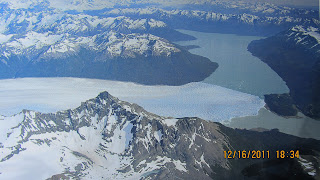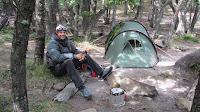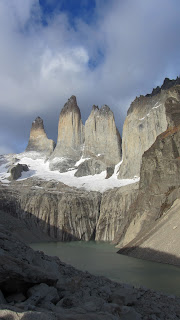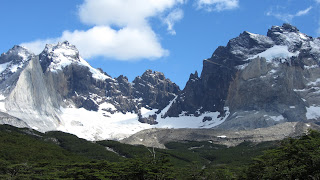Puerto Natales has a tiny airport and our Skyairlines flight was the only one of the day to land. Skyairlines is a Chilean airline and we were very impressed. It cost the same as getting the bus from Santiago but it only takes 4 hours (not 3 days) and we were served 2 meals. People we spoke to who caught the bus had a bumpy, bleak ride on gravel roads instead of breath taking views. The town of Puerto Natales is full of hostels, outdoor shops and travel agencies selling tours. We stayed the night at Niko's II Adventure, whose owner kindly picked us up from the airport.
After a good night's rest we caught an early bus to El Calafate in Argentina. My emergency passport raised a few eyebrows at the border crossing, but they let me through! El Calafate is another town full of hostels, outdoor shops and tour agencies. We received a very friendly welcome from the hostel we stayed at - Hospedaje Lautaro. The owners left some chocolates on our pillow and gave us advice for our glacier trip. El Calafate's main attraction is the Perito Moreno Glacier, located 80km away in Parque Nacional Los Glaciares.
Glacier Perito Moreno is the most impressive glacier I have ever seen. Glaciers I have seen before were amazing, but they came to an ugly end with dirty grey rocks and gravel (called the terminal morraine). In contrast Perito Moreno comes to a dramatic end, with a 60 metre high jagged ice wall. The glacier is 35 kilometres long, 5 kilometres wide and 60 metres high but what makes it exceptional is that it's advancing (getting longer). Most glaciers are retreating (getting shorter), whilst Perito Moreno is growing by up to 2 metres a day, unfortunately the overall volume (amount of ice) is reducing. This is happening because the glacier is melting and thinning, so the depth is reducing.
We spent several hours at the glacier, viewing it from every angle. The park rangers have used the £18 park entrance fee wisely and created a series of walkways that allow you to get really close without damaging the glacier. The afternoon is the best time to go because this is when most ice falls off the glacier, due to the heat of the day. As big chunks of ice calve (fall) off into the lake they make huge splahes and thunderous explosive booming sounds. The first one we only heard but the second one we watched - mesmerised!
Many chunks fell whilst we were there, but we were never quite quick enough with our camera. However we did take hundreds of photos of the glacier because it looked different and spectacular from every angle. Whilst we were there the sun came out which completely changed the colour of the glacier, so we had to take hundreds more photos! However no matter how many photos we took you couldn't quite capture the beauty and the atmosphere.
We moved on from El Calafate to El Chalten, the small town at northern entrance to Parque Nacional Los Glaciares. We were rewarded with outstanding views of Mount Fitz Roy (3405m) as we approached the town. This was the last time we saw the summit because cloud hung over it for the next few days.
The park ranger who welcomed us to the area told us we were very lucky to see the mountain! He also informed us that the free campsite we hoped to stay in was closed and the one cash machine in town was not working. Fortunately we had all our food with us and there was another free campsite, but we would need to hike 1 and 1/2 hours (7km) uphill to reach it. After a rather sweaty climb we reached Laguna Capri and set up camp. The forest campsite was very basic (composting toilet only) but pretty.
Relieved to be free of our big bags we contined our hike to Laguna de Los Tres. This section of the hike (11km return) took us very close to the base of Mount Fitz Roy but the blue skies of the morning were gone and grey cloud clung to the mountain tops. In fact as we headed back down from the viewpoint it started to rain, so we took refuge in a wooden shelter. Also sheltering were some Canadian climbers we had met on our flight- they had scaled the mountain earlier that day in blue skies. Unfortunately the rain wasn't going to let up, so we put on our waterproofs and headed back to camp for our delicious pasta!
The rain had cleared by the next morning but the cloud still clung to the mountain. We made our breakfast on the shores of the lake and waited fit a glimpse of the top, but no such luck. Instead we decided to hike to the viewpoint for Cerro Torre (3102m). It was a pleasant 4 hour stroll past Laguna Madre e Hija and along the wooded paths, but the low cloud refused to budge. Mr Greenhead used his mountaineering skills to lead us back to camp via an alternative route which wasn't marked on our map.We got an early start the next day and headed back to El Chalten town centre to catch an 8am bus. Only the bakery was open where the smell of freshly baked croissants tempted us to spend our last few Argentinian pesos. The rest of the day was spent on buses travelling back to Puerto Natales in the Chilean part of Patagonia, where we received a warm welcome from the owners of Hostal Lili Patagonicos.
Puerto Natales is the gateway to the most famous national park - Parque National Torres del Paine. Thousands of people visit each year to hike for a day or several days, all hoping to catch sight of the 2800m granite pillars called the Towers of Paine. You can pay hundreds of pounds and stay in fancy hostels which provide food or take your own supplies and stay in free campsites. We met a German couple who went for the £550 expensive option, whilst we went for the £130 (transport, entrance fee, food, camping for 2 people) cheap option. Either way it turned out to be one of the highlights of our trip.
We stocked up with food in town, then caught a minibus out to Laguna Armada where we paid our entrance fee. From here we got our first glimpse of the granite towers but the swirling grey cloud kept closing in. The weather here can be wild and unpredictable with sudden rain storms and strong winds, so we snapped photos quickly incase this was our only chance.
The first 7.5km is along a gravel rod to the only hotel in the park. As we walked along several hotel guests whizzed by in their mini buses, so we had to choose our path carefully and avoid the dust! Once past the hotel we started to climb uphill, following the path of the river. We gained about 800 metres in height over 9.5km, which took us about 3.5 hours - our big bags felt heavy by the time we arrived at camp The scenery was dramatic with jagged peaks on one side and the steep sides of the valley (Valle Ascencio) on the other.
We passed the hostel and campsite at Campamento Chileno and headed on to Campamento Torres. This free campsite at the base of the Torres del Paine exceeded all our expectations. Despite being free it had a park ranger living there, organised plots to pitch your tent in, a wooden cooking shelter and a flush toilet! We quickly put our tent up, ate dinner and collapsed into bed.
Our decision to push on to this higher campsite was rewarded the next morning. We got up early and after a 45 minute uphill hike, we arrived at the Mirador de Las Torres (viewpoint of the towers). As we approached the viewpoint clouds started to gather and we thought we were too late, but the rising sun burnt them away.
We got some amazing pictures as the clouds lifted and the sunlight changed the colours of the rock. Within 20 minutes of us arriving the clouds were gone and the soaring, vertical towers were framed by a blue sky. Captivated by their beauty we spent an hour at the mirador, before heading back down to the campsite.
As we headed down the clouds gathered again and settled back on top of the towers, which shows how quickly the weather changes here and that you need to get an early start to see the towers.We packed up camp and headed back down the valley (9.5km), then onto the next stage of the 4 day W trek (named for the shape of the route you walk). This next 11 km section winds its way along the strip of land between Lake Nordenskjold and the mountains. The land gently undulates (goes up and down) rewarding you with views of turquoise lakes, jagged mountains and brilliant green patches of forest. The colours are so vivid that you have to print them on your brain - no photo we took was going to capture the full beauty! The landscape was even more spectacular due to the weather - sunshine and whispy high clouds - very unusual for a place that has similar weather to Wales.
Our next stop was Campamento Los Cuernos, a lovely looking hostel and a rather squashed campsite, but not our final stop for the day. However we did have a look around and bought a couple of cold cokes to drink on the decking. The final 5.5km to Campamento Italiano brought us right onto the shores of the lake, then back into the forest. By now we had hiked 26km (about 16 miles) with our heavy rucksacks, so we were very happy to reach the campground.
The campsite was another free one in a pretty forest location with a ranger, cooking shelter and flushing toilets! The ranger welcomed us and explained the importance of avoiding starting campfires. There are signs everywhere about not starting fires, so we were appalled to learn about the devastating fire which broke out 3 days after we left the park. Apparently an Israeli tourist was burning his group's toilet paper and the fire got out of control. The effects were diastorous with 125 square kilometres burnt down, which is 5% of the park. Tourists had to be evacuated and it will take years to regrow the trees. It made us really sad to think that the pristine, beautiful park we visited could be destroyed so quickly and easily.
We listened carefully to the ranger then set up our tent, cooked up our pasta and settled into our sleeping bags to read our books. An early night meant we woke up early and set off hiking whilst others tucked into their breakfast. The first 11km of the day involved us hiking up a valley and back again, so we could leave our stuff at the campsite and take just the essentials (snacks, water, waterproofs and first aid kit). Fortunately it was another sunny/ cloudy day so our waterproofs were not needed.

The scenery changed again as we hiked up Valle del Frances. We hiked through lush green forests, between dead silver trees and past huge glaciers which kept on giving birth to mini avalanches - impressive to watch and listen to. But the most impressive sight was the ampitheatre of mountains at the head of the valley. As we walked towards the wall of rock, we felt like tiny ants. The colour and shape of the rock was different from every angle, which made Mr Greenhead want to climb up the faces. Unfortunately we had no ropes so he had to be content with taking photos from the viewpoint.

We returned down the valley and packed up our tent, before heading the 6.5km to our next campsite. Tonights campsite was on the shores of the beautiful Lago Pehoe and cost us the grand sum of £10, but this did include hot water, showers (we had no towels) and a clubhouse. The campsite was in a field next to a hostel that slept 200 people, so we also had facilities such as a cafe and a shop. We decided to treat ourselves to some crisps and eggs after 3 days of pasta! Despite these extra luxuries we preferred the simplicity of the free campsites in the forests.
The final part of the W Trek involved us hiking to Glacier Grey, along a path that was parallel to the east shore of Lago Grey. This section involved the same start and finish point (Lago Pehoe campsite), so we were able to leave our tent up and hike the 22km with only essentials. Lago Grey lives up to its name with its drab colour, but your attention is distracted from this by the mini icebergs floating in the water. The path is steep and exposed to the wind in places, but it is sheltered and gentle inbetween. The wind had picked up today and there were more clouds but we only had a few drops of rain.
About half way there, a viewpoint for Glacier Grey allowed us to see this amazing glacier for the first time. Like Perito Moreno, the glacier ended in a wall of ice and chunks were falling into the lake. It is 28km long, 6km wide and 30 metres high - wow! After looking from a distance, we continued on to Refugio Grey (a hostel) for a closer look. The sun had come out by now, so we stopped at this new looking hostel for a cold drink of coke. Then we headed a little further for some close up photos.
The journey back to our campsite saw the sky turn grey and the wind was much stronger. This was the type of weather we had expected the whole time, not the blue skies and calm wind we had been getting. By the time we got back to camp the wind was howling and we were glad of the clubhouse to cook our food in. We were also very happy to have a tent designed for the mountains, which meant it could cope with the wind - unlike some of our fellow campers whose tents were flimsy and blowing away.
The wind was still pretty strong the next morning, but we were distracted by the beautiful sunrise which made the mountain behind our campsite (Cerro Paine Grande) glow. The sunrise meant getting up at 5.30 am and packing up wasn' t too bad. We had to get up early to make sure we arrived at the bus pick up point - 18km away - on time. You can catch a boat from the campsite to the bus pickup but we decided to save our pennies and hike.
The route through the grass plains and past a couple of lakes was gentle but windy. It was a pleasant stroll, but the landscape was pretty tame compared to the rest if our hike and we were keen to be finished. We arrived at the park administration centre in plenty of time and lay reading our books in the sunshine until our bus arrived.
The hike was a fantastic experience, but we were very glad to get back to our hostel, put on clean clothes and have a hot shower. We just made it in time to the supermarket too before it shut for Christmas - we had arrived back on Christmas Eve. The hostel was putting on a dinner but to our surprise Chileans eat Christmas dinner on Christmas Eve. The dinner was a bit of a disappointment (humous, rissotto and biscuits) and made us start thinking about the Christmas food we were missing out on! Mr Greenhead did his best to create a traditional dinner on Christmas day, but without stuffing and pigs in blankets it wasn't the same - though the roast potatoes were delicious. To make matters worse when we had a video chat with our families they showed us the delicious meals they were eating.
Christmas day and boxing day are big family events for us when we are in England, so it was very strange to spend Christmas day and Boxing day in a very quiet hostel reading. We couldn't even watch Christmas films because the tv was broken. It made us wish we could have flown home on Christmas Eve the come back on the 27th! We loved Patagonia but were happy to fly back to the hustle and bustle of Santiago on Boxing day. It was back to La Chimba hostel for our final few days in Chile.
We settled back into our routine of lazing in the gardens of the hostel, buying lunch from the bakery and exercising in the outdoor gym when the temperatures cooled in the evening. We also visited our favourite parks again to take photos and finally made it to the top of Cerro Santa Lucia which allows you to have 360 degree views of the city.
Our last night in Santiago was New Years Eve which meant the whole city was celebrating. When we went for a walk in the day, there were party poppers (1 metre long tubes - perfect for Mrs De'ath!) being sold on every street corner. In the evening, our hostel had a party with a BBQ, beer and wine. The cooking was a little disorganised but Mr Greenhead took his turn at the grill and we managed to grab some of the spoils. It was a fun evening chatting to other guests, watching the fireworks and saying goodbye to Chile.











































































Well that's goodbye to South America. What an adventure.... I think Cordillara Huayhuash Trek
ReplyDeleteis probably one of the places I would like to go.. oh and La Chimba to see the cat!
Adios y hasta luego, Mum x